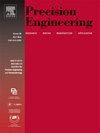Microwave plasma modification-assisted shear-thickening polishing of single-crystal silicon carbide
IF 3.5
2区 工程技术
Q2 ENGINEERING, MANUFACTURING
Precision Engineering-Journal of the International Societies for Precision Engineering and Nanotechnology
Pub Date : 2025-02-16
DOI:10.1016/j.precisioneng.2025.02.010
引用次数: 0
Abstract
This study addressed existing limitations on the efficiency and efficacy of SiC processing by introducing an innovative microwave plasma modification-assisted shear-thickening polishing (MPM-STP) technology. First, the modification mechanism and effects of microwave plasma irradiation on the surface of a single-crystal SiC workpiece were explored. The formation of SiO2 product by plasma modification was confirmed by X-ray photoelectron spectroscopy, and nanoindentation testing indicated an accompanying significant reduction in the hardness and elastic modulus of the SiC from 37.04 GPa to 4.71 GPa and from 504.57 GPa to 68.96 GPa, respectively, enhancing its processability. A systematic investigation of the changes in workpiece surface morphology under various microwave irradiation times, power levels, and distances revealed that a longer irradiation time and higher power level intensified the surface modification effect, and the irradiation distance had a crucial influence on the uniformity of the modified film, which could be optimized through precise adjustment of the irradiation parameters. Next, plasma-modified SiC workpieces were subjected to shear-thickening polishing using a CeO2 abrasive, resulting in the complete removal of the modified film within 15 min and a substantial reduction in surface roughness Ra from 9.74 nm to 0.31 nm, indicating significantly improved surface quality. Finally, the results of nanoscratch experiments conducted on the surfaces of SiC workpieces before and after plasma modification indicated the transformation of the material removal mode from brittle fracture to plastic removal, which is crucial for improving processing efficiency and surface quality. The successful construction of a surface modification model for single-crystal SiC processed by MPM-STP in this study opens a new path for the high-precision machining of SiC materials.
求助全文
约1分钟内获得全文
求助全文
来源期刊
CiteScore
7.40
自引率
5.60%
发文量
177
审稿时长
46 days
期刊介绍:
Precision Engineering - Journal of the International Societies for Precision Engineering and Nanotechnology is devoted to the multidisciplinary study and practice of high accuracy engineering, metrology, and manufacturing. The journal takes an integrated approach to all subjects related to research, design, manufacture, performance validation, and application of high precision machines, instruments, and components, including fundamental and applied research and development in manufacturing processes, fabrication technology, and advanced measurement science. The scope includes precision-engineered systems and supporting metrology over the full range of length scales, from atom-based nanotechnology and advanced lithographic technology to large-scale systems, including optical and radio telescopes and macrometrology.

 求助内容:
求助内容: 应助结果提醒方式:
应助结果提醒方式:


